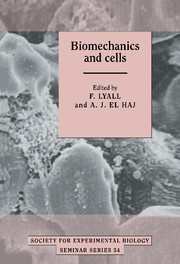Book contents
- Frontmatter
- Contents
- List of contributors
- PART 1 SOFT TISSUE
- PART 2 HARD TISSUE
- Cellular modelling of mechanical interactions with the skeleton
- Mechanical and hormonal influences in vivo cause regional differences in bone remodelling
- Mechanically sensitive cells in bone
- Mechanical stress and bone development
- Application of homogenous, defined strains to cell cultures
- Role of arachidonate in load transduction in bone cells
- Effects of mechanical stretch on actin polymerisation in fibroblasts of the periodontium
- Modulation of cartilage extracellular matrix turnover by pulsed electromagnetic fields (PEMF)
- Index
Application of homogenous, defined strains to cell cultures
Published online by Cambridge University Press: 19 January 2010
- Frontmatter
- Contents
- List of contributors
- PART 1 SOFT TISSUE
- PART 2 HARD TISSUE
- Cellular modelling of mechanical interactions with the skeleton
- Mechanical and hormonal influences in vivo cause regional differences in bone remodelling
- Mechanically sensitive cells in bone
- Mechanical stress and bone development
- Application of homogenous, defined strains to cell cultures
- Role of arachidonate in load transduction in bone cells
- Effects of mechanical stretch on actin polymerisation in fibroblasts of the periodontium
- Modulation of cartilage extracellular matrix turnover by pulsed electromagnetic fields (PEMF)
- Index
Summary
Introduction
Nearly all types of cells, prokaryotic and eukaryotic, can respond to the mechanical environment. This environment may be due to environmental stresses (e.g. wind, or activity, perhaps also gravity) or vibrations (e.g. sound), the difference being merely the amplitudes and the frequencies involved. Distortions of some parts of the cell or tissue are caused and this distortion is transduced into an electrophysiological and/or biochemical response. In some protists, organelles have become adapted into vibration sensors and can elicit evasion or aggression responses. In many multicellular organisms groups of cells can be adapted as vibration sensing-organs. For instance, in coelenterates special cells act as sensors to release a trigger mechanism controlling the nematocysts for prey capture (Golz & Thurm, 1991). Plants can adapt to environmental wind forces and also to gravity (Gehring et al., 1990). Specialised organs exist in animals to transduce small mechanical loads, such as vibrations, and link this transducer to the nervous system. Strains induced by stresses in the swim bladder of fish are detected, which can aid in prey capture or predator evasion (Canfield & Eaton, 1990). The sensory hairs of vestibular ampullae (similar to the cochlea) provide an example of an organ where small vibrations are amplified by exploiting the production of shear between two surfaces (Nagel et al., 1991). Interaction with the mechanical environment leading to adaptation of tissues is also necessary in non-specialised cells to allow the organism to maintain the correct functional balance of its tissues.
- Type
- Chapter
- Information
- Biomechanics and Cells , pp. 197 - 219Publisher: Cambridge University PressPrint publication year: 1994
- 3
- Cited by

